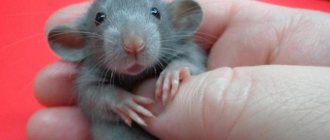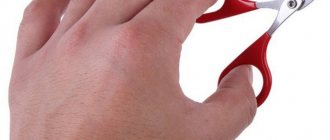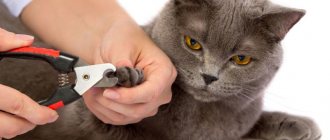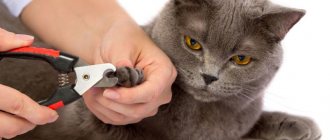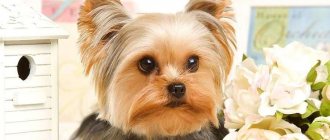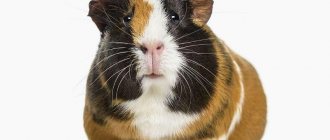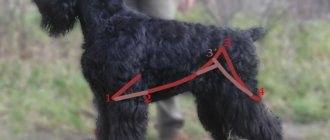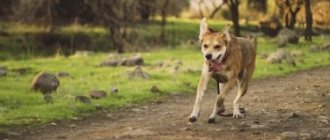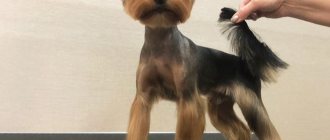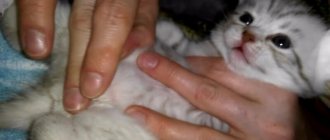Caring for rodents includes not only their timely feeding and cleaning of the cage, but also procedures that are not entirely convenient for most owners, in particular, trimming their claws. When they grow excessively, not only the appearance of the paws deteriorates, but also the ease of movement of the animal, so every owner should find out whether it is possible to trim the claws slightly on their own, and how to do it correctly so as not to harm the pet.
Do I need to trim my guinea pig's nails?
In nature, guinea pigs' claws grind down on their own, but this is impossible at home, so the procedure must be carried out by a person. If you do not do this regularly, the consequences may be as follows:
- skin injuries from ingrown claws;
- difficulties in moving, which can subsequently lead to the pet becoming overweight due to low activity;
- injuries to various areas of the skin from scratching with long claws;
- infection due to dirt under the claws and its introduction into the wounds;
- curvature of the fingers, as long claws curl and become rough;
- spinal displacement;
- the appearance of pododermatitis;
- damage to furniture, wallpaper, floors in the house.
Considering all the facts, the answer to the question “Does a guinea pig’s nails need to be trimmed?” disappears on its own.
Nail trimming
Certain rules of care, like other animals, are required for guinea pigs. They should have their nails trimmed periodically. It is best to use a nail clipper for small animals (a cat clipper will do).
As the claws grow, they begin to curl. This can lead to crooked toes, changes in spinal alignment, foot pad injuries, and pododermatitis. In addition, with long claws it is simply uncomfortable for an animal to walk. The procedure should be carried out as needed, on average 1-2 times a month, when the length of the transparent part is 2 mm or more. Notice that the vessels grow along with the claws. Thus, the longer the claw, the longer the vessel.
On some websites you can find information that pigs' claws need to be trimmed from the age of 1 year. Apparently, such sites and articles were written by people who have never kept pigs. Nails should begin to be trimmed from 1-3 months of age (depending on the growth rate).
How to trim claws correctly
Pigs have four toes on their front feet and three on their back feet. The nails on the hind feet are naturally longer than those on the front feet, so when trimming the nails on the back feet should be left slightly longer than those on the front feet. In addition, remember that the claws should be trimmed at a certain angle so that the paw can rest comfortably on the surface.
When starting to trim the claws, take the pig in your arms and turn it with its back towards you, while supporting its butt. It’s easier to cut with two people. But, if the pig is calm and tolerates the procedure loyally, you can cope on your own.
It is necessary to trim claws in good lighting. It is convenient to carry out the procedure under a lamp in order to be able to examine the claws in the light - this will help to see blood vessels that should not be touched when cutting. You can only shorten the claws within the transparent area, since if you touch a vessel, bleeding will begin. A few drops of blood will quickly clot, but the pig will still experience discomfort. You should especially carefully trim the claws of dark-colored pigs, since the blood vessels on their claws are practically invisible.
To ensure that the nails do not have jagged edges after trimming, you can use a nail file. Also, a file can be useful for shortening the claws of dark pigs. If the claws are not too long, use only a nail file, but if this is not enough, then trim the claws with a nail clipper, carefully, millimeter by millimeter, removing the overgrown claw.
Trim your claws in a timely manner, do not let them grow too long, since the longer the claw, the longer the blood vessel becomes. Thus, if you miss the moment of trimming, then later you will have to leave the nails longer than you would like.
Video author: Anna Simchuk
If the pig really doesn’t like this procedure and breaks out a lot, then you can:
- swaddle in a towel and pull out 1 paw at a time, which needs to be cut; cut hair in the bathroom with the water turned on (many pigs, due to their fear of water, fall into a stupor at the sound of it); distract the pig with food (give your favorite greens in your mouth while you perform the manipulations); put on a muzzle for small breed dogs (if they bite badly). Photo: Vyacheslav Belorusov
What happens if you don't take care of your animal's claws?
When and how to cut a guinea pig's nails?
Nail trimming should be done every two to four weeks, starting when your guinea pig is one month old.
Trimming guinea pigs' nails is not difficult, as there are many nail clippers, electric sharpeners and rodent scratching posts available. At a pet store or veterinary pharmacy, you should buy special tweezers - nail clippers for rodents. Before buying, you need to hold it in your hand and make sure that it is comfortable. If you feel uncomfortable, the risk of injury to the animal increases. There are also electric sharpeners that are considered even safer.
IMPORTANT! There are blood vessels in your pet's claws, so you need to carry out the procedure very carefully.
There are special nail clippers for this procedure.
How often should I do this?
For the first time, guinea pigs' claws are trimmed between 1 and 3 months, when the claws have already begun to bend and grow to the sides. In the future, the need for another procedure is determined by the rate of bone tissue growth; on average, it is performed once every 2–4 weeks, as soon as the length of the claws exceeds 2 mm.
After using the hemostatic powder, its remnants must be removed so that the chemical does not get into the pet’s mouth. The most minor consequences of this will be indigestion and vomiting.
Preparation for the procedure
In order for the procedure to be safe for the rodent both psychologically and physically, you need to prepare in advance.
Important! Choose a place with good lighting in advance and arrange all the equipment in the correct order.
Nail clipper for rodents
At a pet store or veterinary pharmacy, you should buy special tweezers - nail clippers for rodents. Before buying, you need to hold it in your hand and make sure that you are comfortable. If you feel uncomfortable, the risk of injury to the animal increases.
Electric sharpener or scratching post
In addition to regular nail clippers, there are electric sharpeners. They are considered even safer for rodents, since it is almost impossible to catch a nerve or vessel with them.
IMPORTANT! It is strictly forbidden to use scissors, either regular or manicure. Their use can cause the animal’s delicate nails to peel.
Hemostatic powder
If a vessel was damaged during the procedure, you should use a hemostatic powder, which is also sold in pet stores and veterinary pharmacies. If it is unavailable, you can use corn starch or chlorhexidine.
ATTENTION! Before releasing the animal, you need to remove the hemostatic powder from the paws so that it does not get into the pet’s respiratory tract.
Towel
A towel is necessary for the animal’s comfort and convenience when holding it during the procedure.
You need to wrap your pet in a towel as soon as you take him out of the cage and turn him with his back to you so that he cannot bite .
Is your rodent good at being handled? The procedure can be made painless for the animal
How to cut your hair at home
With a competent approach to trimming rodents' claws, the process itself at home will not be much different from the procedure in a pet salon or veterinary clinic. In any case, it consists of a preparatory stage (involves the acquisition and disinfection of all necessary tools and materials), as well as the sequential implementation of direct pruning, with strict adherence to the basic requirements for it.
What you need to prepare
If you already have rodents and you want to provide them with proper care, in addition to drinking bowls, bowls and houses, you should purchase a “manicure set”, which includes the following items important for cutting nails:
- a special nail clipper for rodents (if there is no place to buy one yet, an alternative would be children’s nail clippers or tongs/scissors for cats);
- an electric sharpener or scratching post (safer than the first option, because it helps to sharpen the claws to the desired length without the risk of touching blood vessels or nerve endings);
- hemostatic powder (sold in specialized stores with shaving accessories), starch or “Chlorhexidine”, which will come in handy if you still do not calculate your strength and damage the capillary;
- a towel (it is optional, but it will make it much easier to hold the guinea pig in your hands, and it will feel much more comfortable during the procedure);
- a fluorescent lamp to clearly see the preferred place to cut the claw.
Pruning rules
Trimming nails is stressful for most animals, so in order to complete all the steps as quickly and accurately as possible, you should follow some simple rules:
- It is better to start cutting the claws from the outermost finger and cut them in order, without missing a single one;
- if the animal begins to worry and struggle, take a short break so that the pet calms down;
- if necessary, try to distract the rodent after each claw cut by offering him his favorite treat;
- in some cases (mainly with very obstinate guinea pigs), it would be more logical to extend the process of trimming claws over several days;
- it is much easier to deal with the nippers if you involve another person in the procedure: one holds the animal, and the second quickly removes the excess part of the claws;
- To avoid problems with trimming the claws of guinea pigs in the future, it is advisable to accustom them to this at an early age, so that the rodent gradually gets used to the procedure and is no longer so worried.
Video: rules for trimming claws
With regular trimming of the tips of the claws, the animal's paws will always remain well-groomed, and it will not experience problems with its limbs.
Did you know? Guinea pigs are social animals. Not only do they prefer to live in packs, most of them need attention from humans, so for their harmonious development you will have to pet the rodents daily.
Procedure process
Having familiarized yourself with all the recommendations for the haircut process and having prepared the necessary tools and materials, it’s time to proceed to the actual procedure, based on the following step-by-step instructions:
- Carefully, without sudden movements, remove the pet from its cage, holding its jaw with the thumb of one hand and securing the animal from behind with the other.
- Wrap the animal in a prepared towel and place it on your lap, first turning it with its back (in this position it will not be so easy for it to bite).
- Try to calm your guinea pig by periodically stroking it and treating it with treats.
- If the pet is not aggressive and remains relatively calm, remove one paw from the towel and fix the claw of interest with your thumb and forefinger. You shouldn’t squeeze too hard, and if the rodent has already begun to worry, loosen your grip and wait until he calms down.
- Take the pliers in your free hand and place the tool in front of the claw.
- Determine the location of blood vessels in the tissues (for convenience, you can move the paw closer to the light source or shine it with a flashlight).
- Using clippers, cut off the desired part of the nail, just above the blood vessel. If it was not possible to determine its specific location, you need to cut off the claw in small parts.
- If blood does come out, stop it using a special powder or starch, simply sprinkling the substance on the cut site.
Once the nail trimming is complete, the animal is returned to its cage and allowed to calm down.
How to properly trim a guinea pig's nails
- First of all, the pet must be removed from the cage safely, slowly and without sudden movements, so as not to anger the pet;
- After this, the animal needs to be wrapped in a towel so that it is comfortable, and placed on your knees with its back to you to avoid bites;
- After placing the guinea pig, you should pull the paws out of the towel one at a time and treat each one separately;
- Having secured the claw between your thumb and forefinger, you need to take the device with your free hand and carefully trim the claw without touching the vessel.
- If blood does appear, you should immediately use a hemostatic powder.;
- If, after completing the haircut, there are uneven areas on the nails, you should treat them with a nail file;
- After the procedure, it is recommended to replace the bedding so that dirt from soiled sawdust does not get under the rodent’s trimmed claws.
How to make the procedure as painless as possible
- To understand the exact location of the vessel and not touch it, you can illuminate the claws with a lamp or flashlight and trim only the transparent tip. If your rodent's claws are dark, you can carefully use a nail file to file down the tips.
- In order for your pet's paw to stand straight, you need to cut the claws at an angle without touching the vessel.;
- A rodent should be accustomed to trimming its claws from childhood, one month, then it will get used to it and will stop worrying with age.
- To prevent bites, you can put a muzzle on your rodent for miniature dogs.
- The nails should be trimmed sequentially, moving from one finger to the other, starting from the edge.
- If it’s difficult for one person to hold a pig and trim its claws at the same time, you can try together - it’s faster and more effective . If one holds the rodent, it will be easier for the other to handle the nippers.
- It is necessary to carry out the procedure regularly, because in case of strong regrowth, the trimming process will be more difficult, and the animal will suffer from deformation of the paws.
What to do if your pig is worried?
You need to understand that this is quite a stressful situation for the animal and you need to be prepared for its anxiety. It is important to carry out the procedure quickly, but, more importantly, carefully.
It is best to distract your pet with his favorite treats, such as an apple or celery. If your pet pulls its paw out, there is no need to try to stop it; it is better to wait a few minutes until the animal calms down, and then try again.
If your pet doesn’t want to obey at all, you can trim his claws in the bathroom or kitchen by turning on the water; at this sound, the guinea pig will simply freeze.
When the owner of a pig has doubts about whether or not it will be possible to trim the claws himself, you can contact a veterinary clinic.
Special scratching posts are sold for guinea pigs.
If your pig is worried
If your pet is worried while trimming its nails, here are some tips on how to calm it down.
- If the pig withdraws its paw, do not hold it. Release your paw, pet the animal, calm it down, give it a treat, and then try again. There is no need to pull the paws to make cutting more convenient; you can lightly press on your finger and the nail will “open” to its full length. The rodent should also be given a treat after each treated paw. Thus, the animal develops a trusting attitude towards the manipulations being carried out.
- If there are continuous attempts to escape, the pet is wrapped in a diaper or towel and held tightly.
- You can calm your pet with a distracting technique, for example, offering a treat or moving to the bathroom or kitchen and turning on the water there. At the sound of running water, guinea pigs freeze. You can feed your pet your favorite food throughout the entire procedure if it makes your pet feel calmer.
- If your pet behaves aggressively, use a muzzle for small dogs or cats.
- If you can’t trim your beloved pet’s nails, it’s best to seek help from a veterinarian or pet salon.
Guinea pigs do not require much care, are unpretentious in food and at the same time are ready to please their owners with their attention. But cutting your guinea pig's nails must be included in the list of grooming procedures.
Nail care
To make this not very pleasant procedure for a rodent rare, its living conditions should be brought closer to natural ones.
To do this, you need to buy a scratching post at a pet store or use a rough stone or piece of brick for this purpose, which will contribute to the natural grinding of the claws.
If possible, you can make a pyramid of bricks or stones in your pet’s cage so that he can climb along it and thus sharpen his claws. Treats should be left on top to motivate your pig.
IMPORTANT! Make sure that the pyramid is stable, otherwise this slide may fall on the rodent and cause injury.
How are rodents' nails trimmed?
A guinea pig has only twelve toes: four on its front paws and three on each back paw. When starting to trim your nails, remember two important points:
- The nail plate should be trimmed at such an angle that the animal can comfortably rest its paw on the ground.
- On the hind legs, the claws of rodents are naturally longer, so when processing, also leave a couple of extra millimeters on them.
Usually it’s easier to trim an animal’s nails together, but calm animals that don’t bite or try to escape can be easily handled by one person.
Trimming a guinea pig's claws is quite simple; just follow a few simple rules:
- The most comfortable position for grooming looks like this: the owner turns the animal with its back to itself and supports it under the butt with one hand.
- Sometimes you may need a regular nail file. If the claw has not grown too much, you can abandon the nail clipper and simply file down the extra millimeters, getting rid of them. Also, a nail file is simply indispensable for combating nicks that often remain on rodents’ nails after cutting.
- Be sure to carry out the procedure in a room with good lighting, and ideally, directly under a lamp (for example, a table lamp). This way you can see where the blood vessels located inside the nail plate pass, and you can shorten the claws without damaging the animal’s paw.
- Before starting the procedure, you should make sure that your pet is calm and in a good mood, otherwise the haircut may end badly for both of you (it is best to take the pig immediately after waking up, then it will be less active).
- You need to be especially careful when treating the nails of pigs of dark colors, because their claws are almost black, so it is not always possible to see the vessels inside.
It is extremely important to get your hair cut on time. Otherwise, not only the claws will become longer, but also the blood vessels passing through them, which means the risk of damaging them and causing pain to the pet will increase.
What will you need?
Preparing for nail trimming involves having the following tools.
- Nail clipper, nail clippers or electric sharpener. The last tool can be considered the safest.
- Special hemostatic powder . It can be purchased at stores that stock shaving supplies. It will help stop bleeding if you accidentally touch a vessel while trimming the claws. If the powder is not available, then use a chlorhexidine solution.
- Terry towel . It should be soft and voluminous.
- A small nail file. With its help, irregularities are removed after trimming the claws of a guinea pig.
Please note that it is better not to use nail scissors to trim your pet’s nails. The fact is that they will not be able to instantly shorten the tip, which will complicate the procedure.
Preparation
First of all, you should prepare all the necessary tools:
- You can use nail clippers for children or purchase special ones at a pet store. The second option is preferable, because such a device does not allow the nails to compress, thereby causing unnecessary discomfort to the pet.
- Styptic powder is available in the shaving aisle. It can be replaced with cornstarch. The product will help stop bleeding if a blood vessel is touched during cutting.
- A towel is needed to make it more convenient to hold the rodent during the procedure. An animal wrapped in a towel will feel more comfortable.
A place for trimming claws should be organized in advance. Tools should be laid out so that any tool can be taken quickly and conveniently.
Trimming guinea pigs' nails is a lot of stress for the rodent. Therefore, the pig itself also needs to be prepared for the procedure:
- It is necessary to remove the animal from the cage in a safe way so as not to anger it. Slowly, without sudden movements, a hand is inserted into the cage. The thumb of one hand should hold the jaw, and the other hand should hold the pig from behind.
- Then you need to wrap your pet in a towel so that he is comfortable.
- The animal should be placed on the lap with its back to the owner so that it does not bite him.
- Before trimming its nails, it is imperative to calm the pig with petting or treats. Allowed delicacies include pumpkin and celery.
About the animal
The guinea pig is an unpretentious and funny animal that adapts well to home conditions. Externally, it is much larger than a hamster or a decorative rat. The rodent is distinguished by its cylindrical body shape and sharp teeth. Depending on the breed, guinea pigs are divided into short-haired and long-haired. The color of pets is striking in its diversity: from dark burgundy to silver.
Fluffy “piglets” can be called long-livers. They live 10–15 years. A lot depends on care.
In particular, trimming the claws of a playful animal is a mandatory procedure that should never be neglected.
Preparing tools
The most sensitive part of a guinea pig is its claws. The claw contains pulp with blood. If you trim the nail incorrectly, your pet will bleed, which will lead to serious consequences, including numbness of the limb. How to trim a guinea pig's claws without harming the pet? Thorough preparation is the first step to a successful procedure. Before cutting an animal, you need to purchase the appropriate tools:
- Wire cutters. You can cut it for children or buy a tool in the store.
- Powder to stop bleeding. Beginners who have recently acquired a rodent, when cutting, touch a blood vessel or deform their nails. The powder allows you to quickly stop bleeding. Corn starch is commonly used.
- Terry towel. An animal wrapped in soft fabric will stop being nervous.
